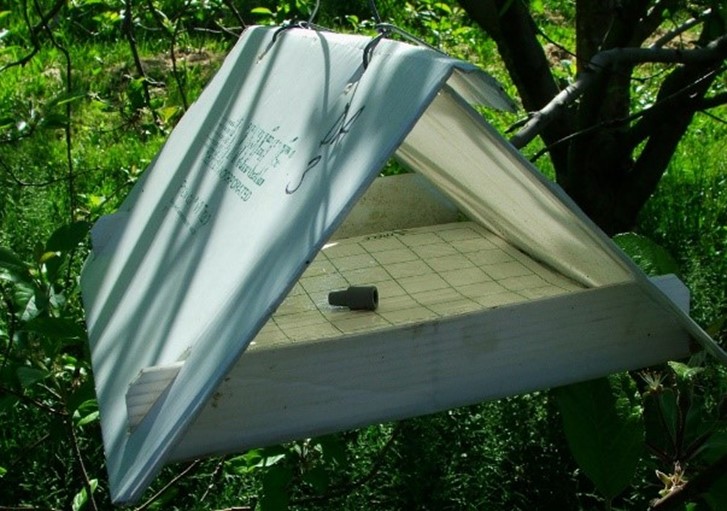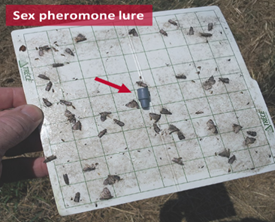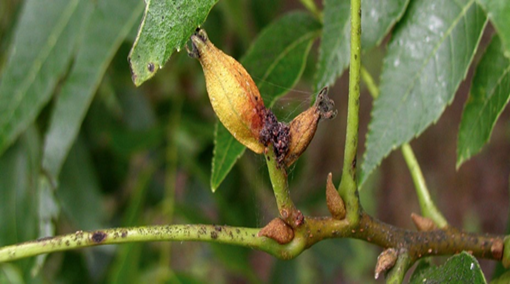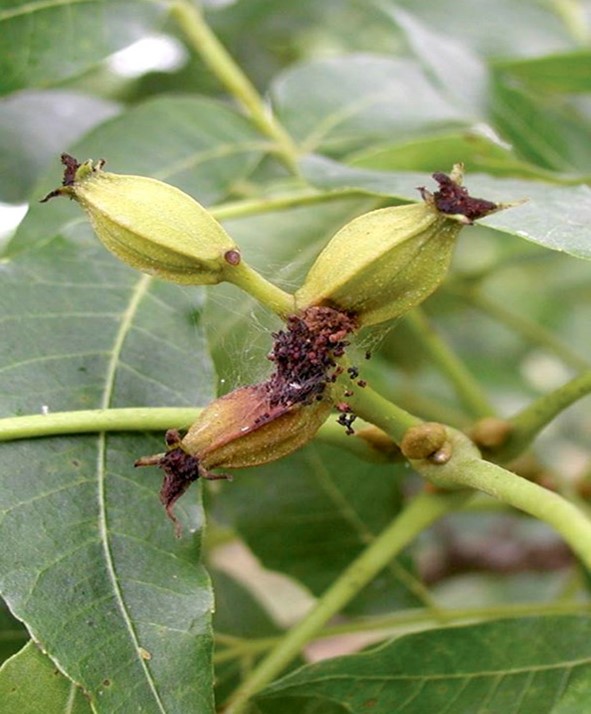Pecan Nut Casebearer Activity Earlier Than Normal
On May 3, collaborators with the Noble Research Institute, Laura Putman and Amy Bridges, reported two consecutive nights of captures of pecan nut casebearer (PNC), thereby, establishing a biofix (1st sustained moth flight) for the site in Burneyville, Oklahoma, along the Red River.
As of May 11, several other locations across the central and north-central parts of the state have reported multiple PNC moth captures as well, so biofix for the northern areas of Oklahoma could be fast approaching. Pheromone traps (Fig 1) are one of our best tools for monitoring this pest. The key to utilizing these traps is to have them out early in order to detect the onset of a flight. However, this year has been a challenge. Due to mild spring conditions and early tree budding, we are about two weeks ahead of schedule. The initial date of collection, when moths are collected acts as a benchmark for predicting egg laying (oviposition).
As I stated in the last PNC news release, EPP- 23-7 in early May, it is suggested that 25-50% oviposition marks the time when scouting for eggs and/or damage should occur. This anticipated oviposition represents 12-16 days after biofix when a treatment decision may need to be made. I am attaching a table (Table 1) depicting three example orchards and how they arrived at the biofix time, note that it requires two consecutive nights of PNC capture.
Table 1. Examples of three orchards where traps were placed and the initial capture dates for male PNC. Note when the biofix was established for each site.
| May 14 | May 15 | May 16 | May 17 | May 18 | May 19 | May 20 | Biofix | |
|---|---|---|---|---|---|---|---|---|
| Orchard #1 | 0 | 0 | 1 | 2 | 1 | 5 | 8 | May 16 |
| Orchard #2 | 0 | 0 | 1 | 0 | 0 | 3 | 5 | May 19 |
| Orchard #3 | 0 | 0 | 3 | 0 | 1 | 3 | 0 | May 18 |
Capturing just one or a few moths on a single, isolated night does not establish the biofix, you must capture moths on two consecutive nights to establish that time. In general, 7-10 days after the established biofix, eggs of PNC will start to be deposited. Trap captures can also help indicate when PNC activity has temporarily ceased (Fig 2). If you find 2 infested clusters before reaching 310 clusters checked, this warrants treatment.
OSU Fact Sheet 7189 “Scouting for the pecan nut casebearer” provides guidelines for scouting. Every three days, growers should be scouting for PNC eggs and/or the first signs of damage (Fig 3 & 4) and continue that process until approximately the middle of June.
Keep in mind, severe weather events can have a profound effect on PNC emergence, mating, and oviposition levels, so it is critical to scout the orchard regularly, especially after storm events like we’ve seen recently. There are times when we don’t see significant first-generation PNC problem throughout much of the state because of weather events happening around the same time as adult activity. Scouting becomes important from the standpoint of putting the grower, rather than the insect, in control of the population and avoiding any surprises.
Figure 1. PNC pheromone traps.
Figure 2. Adult male moths. Ag Pest Monitor.
Figure 3. PNC Damage. Oklahoma State Univ. and Pecan South.
Figure 4. PNC Damage. Oklahoma State Univ. and Pecan South.




